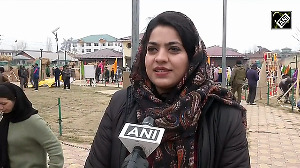Kolkata's vehicular traffic is very much in the fast lane despite the metropolis having the highest density of vehicles per kilometre among all metros.
Kolkata Police, which lays claim to scripting the success story, says the city has a density of 814.80 vehicles, the highest among per km road length as compared to 766.31 for Mumbai, followed by 616.58 Chennai and 170 Delhi.
But in terms of vehicle population Delhi topped the list of metros with 44 lakh, followed by 16.44 lakh in Chennai, 14 lakh in Mumbai and 11.44 lakh in Kolkata.
On the other hand, Kolkata has the minimum road length among all the metros with 1,404 km, followed by 1,800 km in Chennai, 1,900 km in Mumbai and 25,948 km in Delhi.
"Kolkata Traffic Police has been successful in attaining a travel speed of almost 19 km per hour, which is amazing under the circumstances," a traffic bulletin for 2004 said.
Kolkata Police's achievement is to be seen in the backdrop of the major constraints of a burgeoning population, growing number of vehicles, limited road space, regular processions, demonstrations and road blockades by political groups, Kolkata Police Commissioner Prasun Mukherjee said.
Movement of heavy goods vehicles throughout the city in the absence of ring roads as in other metros, absence of a separate terminus for long-distance buses away from the city centre, slow moving vehicles, erratic crowd behaviour and lack of adequate infrastructure to enforce traffic discipline were some of the other factors which affected traffic flow, Mukherjee said.
Deputy Commissioner of Traffic Jawed Shamim said rash and negligent driving caused majority of accidents.
The bulletin said though there were 31 per cent accidental deaths in India, Kolkata was considered safer both for motorists and pedestrians.
A comparative study of fatal cases in four metro cities during 2003 and 2004 said Delhi topped in accidental deaths with 1801 in 2003 and 1782 in 2004, followed by 567 and 588 in Chennai, 394 and 534 in Mumbai and, 442 and 420 in Kolkata.
In case of non-fatal injury during 2003 and 2004 too Delhi topped the list with 7133 and 6749, followed by 6220 and 5562 in Mumbai, 3463 and 4301 in Chennai and, 2154 and 1737 in Kolkata.
Accident deaths in Kolkata have gone down to 420 in 2004 from 452 in 2000, 440 in 2001, 457 in 2002 and 442 in 2003.
Most of the victims of fatal cases in Kolkata were male in the age group of 46 years and above. Interestingly, most of these accidents occurred between 2200 hours to 0630 hours.
One of the prime concerns in traffic management was slow-moving vehicles.
The state government recently decided to ban hand-pulled rickshaws and hand carts, operating under the Hackney Carriage Act.





 © 2025
© 2025